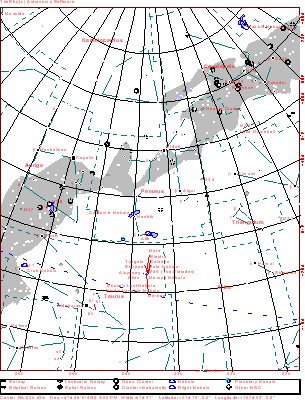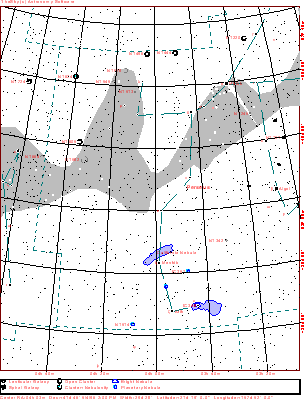
| Home | Deepsky Atlas | TheAstronews | Links | Solar System | ||||||

Hawaiian Astronomical SocietyConstellations: Perseus -- He never Looked her in the Eye |
||||||||||
Aided by Hermes (the messenger) and Athena (the goddess of wisdom, fertility, the useful arts, and prudent warfare), Perseus pressed the Graiae (sisters of the Gorgons) into helping him. The sisters shared one eye and one tooth between them. He seized these items and refused to return them until they provided him with winged sandals (which enabled him to fly), the helmet of Hades (which conferred invisibility), a sickle (with which to decapitate Medusa), and a bag (in which to conceal the head).
Because Medusa turned everybody who gazed at her head to stone, Perseus approached her very carefully, even though she slept when he arrived. Guided by her reflection in the shield Perseus approached. She woke and stared at the shield, stunned by her own reflection. Perseus seized the chance to behead her. By the way, from Medusa's blood sprang forth the winged horse Pegasus.
After saving Andromeda, Perseus returned to Seriphus and rescued his mother from King Polydectes, using Medusa's head. Later Perseus gave Medusa's head to Athena, and returned the winged sandals, Hades' helmet and the sickle to Hermes. He took his mother back to her native Argos, where Perseus accidentally struck her father Acrisius dead when throwing the discus in a tournament, thus fulfilling the prophecy that he would kill his grandfather.
As a constellation, Perseus still holds the head of Medusa, which changes its brightness. Ancient Arabian people thought it was spooky, and called the star Algol, the "demon star" (Algol is Beta Persei, and is the most famous of the eclipsing variables).

Click the map for a 916x1200 version of the above. Click here for a map better suited for use in the field.

This a more detailed view of the constellation. The map displays stars to magnitude 10, and deepsky objects to magnitude 12. Click here for a map better suited for use in the field.

Click here for a map better suited for use in the field.
 84k JPEG. Here's a sample description of the open cluster NGC1582 from Tom Lorenzin's 2000+ Catalog: "7M; 37' diameter; twenty 9M and fainter members; very large, sparse and difficult to detach from the starry background; most of the brighter members are arranged in a large crescent whose convexity faces NW-ward; good binocular object; 40' S and a bit E lies good binocular DBL ST 57 PER (2' separation at PA 200; 6.1-6.8M); both white." Cluster is located 5.4° west of Epsilon Aurigae. Image from the Digital Sky Survey. 84k JPEG. Here's a sample description of the open cluster NGC1582 from Tom Lorenzin's 2000+ Catalog: "7M; 37' diameter; twenty 9M and fainter members; very large, sparse and difficult to detach from the starry background; most of the brighter members are arranged in a large crescent whose convexity faces NW-ward; good binocular object; 40' S and a bit E lies good binocular DBL ST 57 PER (2' separation at PA 200; 6.1-6.8M); both white." Cluster is located 5.4° west of Epsilon Aurigae. Image from the Digital Sky Survey.
|
NGC1491 (Best 82) lies 1.8° to the west, and 1.1° NNW of Lambda Persei. This is a bright nebula, described as very bright, small, irregular in shape, brighter toward the middle and "resolvable." There is a mag. 10.9 star involved. A nebula filter helps with lower powers.
Image is a triple mosaic from the Digital Sky Survey.
|
 93k JPEG. NGC1275 (Caldwell 24) is a small (1.2'x.8'), faint (mag. 11.6), Seyfert galaxy located 2.3° ENE of Algol (beta Persei). Also a radio source called Perseus A, it made the Caldwell listings because it is the brightest of a tightly packed cluster of galaxies too numerous to count. Just up and to the left of 1275 is the double galaxy NGC1278 and 1277. Just down and to the right of 1275 is 1272. Between them and just above them are 1273 and 1274. A good 8" might tease out these and more at a dark site. The cluster comes alive in a high contrast 12" telescope. 93k JPEG. NGC1275 (Caldwell 24) is a small (1.2'x.8'), faint (mag. 11.6), Seyfert galaxy located 2.3° ENE of Algol (beta Persei). Also a radio source called Perseus A, it made the Caldwell listings because it is the brightest of a tightly packed cluster of galaxies too numerous to count. Just up and to the left of 1275 is the double galaxy NGC1278 and 1277. Just down and to the right of 1275 is 1272. Between them and just above them are 1273 and 1274. A good 8" might tease out these and more at a dark site. The cluster comes alive in a high contrast 12" telescope.
|
 85k JPEG. M34 (NGC1039) is a bright (mag. 5.2), very large (35'), open cluster located 7° west of Almach (Gamma Andromedae. It sits on the Perseus-Andromeda border. Dreyer states it contains scattered stars at about mag. 9. 85k JPEG. M34 (NGC1039) is a bright (mag. 5.2), very large (35'), open cluster located 7° west of Almach (Gamma Andromedae. It sits on the Perseus-Andromeda border. Dreyer states it contains scattered stars at about mag. 9.
|
 110k labeled JPEG. NGC1023 (Best 81) is an eliptical galaxy located on the Andromeda border, 3.75° south of M34. The Dreyer description reads very bright (mag. 10.3), very large (8.7'x3'), very much elongated (in p.a. 87°), with extreme brightening toward the middle. Steve Coe reports a "tuft" (NGC1023A) on the east side when viewing it with a 13". 110k labeled JPEG. NGC1023 (Best 81) is an eliptical galaxy located on the Andromeda border, 3.75° south of M34. The Dreyer description reads very bright (mag. 10.3), very large (8.7'x3'), very much elongated (in p.a. 87°), with extreme brightening toward the middle. Steve Coe reports a "tuft" (NGC1023A) on the east side when viewing it with a 13".
Other galaxies inhabit the Digital Sky Survey image, most notable being the spiral IC239 (46' west of NGC1023 and in Andromeda proper), shining at a very faint mag. 11.7 and covering 4.6'x4.2' of sky.
|
 85k JPEG. Collinder 29 is a somewhat rich open cluster (30 stars in a 20' area) located 1.9° west of Eta Persei. Stars range from mag. 7.4-11. The cluster is mag. 5.9. 85k JPEG. Collinder 29 is a somewhat rich open cluster (30 stars in a 20' area) located 1.9° west of Eta Persei. Stars range from mag. 7.4-11. The cluster is mag. 5.9.
|
 49k JPEG. NGC869 & NGC884 (Best 79 & 80, Caldwell 14) is also known as the Double Cluster. It is also one of the showcase objects of the sky. NGC869 (h) is the western cluster that shines at mag. 4.3. Dreyer describes it very, very large (30'), and very rich with 200 stars at mag. 7-14. NGC884 (chi) is a mag. 4.4 cluster described as very large (30), very rich (150 stars from mag. 8.5), with a ruby red star in the middle. Together they are visible to the naked eye, and are in NW Perseus near the Cassiopeia border. A 30 minute exposure though a Genesis refractor, taken July, 1995 by Andy Steere. 49k JPEG. NGC869 & NGC884 (Best 79 & 80, Caldwell 14) is also known as the Double Cluster. It is also one of the showcase objects of the sky. NGC869 (h) is the western cluster that shines at mag. 4.3. Dreyer describes it very, very large (30'), and very rich with 200 stars at mag. 7-14. NGC884 (chi) is a mag. 4.4 cluster described as very large (30), very rich (150 stars from mag. 8.5), with a ruby red star in the middle. Together they are visible to the naked eye, and are in NW Perseus near the Cassiopeia border. A 30 minute exposure though a Genesis refractor, taken July, 1995 by Andy Steere.
|
 39k JPEG. M76, the "Little Dumbbell" (NGC650-1) is a very bright (at mag. 12?) planetary that resembles its larger cousin, M27. It sits on the western edge of Perseus on the border of the Milky Way. At 2.7'x1.8', this is a small planetary nebula. 39k JPEG. M76, the "Little Dumbbell" (NGC650-1) is a very bright (at mag. 12?) planetary that resembles its larger cousin, M27. It sits on the western edge of Perseus on the border of the Milky Way. At 2.7'x1.8', this is a small planetary nebula.
|
If you have any questions about the Hawaiian Astronomical Society
please
(link requires javascript).